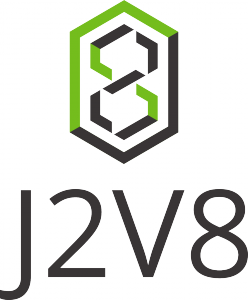Launch Node.js on JVM
Gone are the days when whole companies depended on one technology supplier. Even small firms and amateurs will find the optimal solution for themselves, combining technologies in one project. For a long time, Java has held the lead among server technologies. But today Node.js is everywhere.

But even with the growing popularity of Node.js and JavaScript, Java does not expire. In addition, few organizations can afford to transfer the entire platform from JVM to Node.js. This means that the company must either continue to use the current technology stack, or run several stacks that will communicate via the network API. However, there is another way: run Node.js right in the JVM process. And J2V8 finally made it possible.
J2v8

J2V8 is a set of connectors to V8 for Java. J2V8 packs V8 as a dynamic library and provides Java API for V8 through the Java Native Interface (JNI). With J2V8, you can execute javascript using V8 as well as using Rhino or Nashorn.
J2V8 was originally designed to provide high-performance JavaScript in Tabris.js, a cross-platform mobile library.
Over the past months, I set up the Node.js build as a dynamic library and provided interaction with the Java API for it. Now you can run Node.js scripts directly from Java. Unlike other solutions that try to implement Node.js using other engines, this is a real Node.js with all the bugs and features. Node.js runs in the same process as the JVM and all interaction occurs synchronously via JNI.
Sharing Node.js and JVM
J2V8 provides an API for running scripts in Node.js, invoking JavaScript functions from Java and vice versa, connecting NPM modules and running Node.js message queue. All modules of the Node.js core are also present.
Running Node.js on the JVM makes it easier to migrate to anyone who uses a large Java stack, but wants to start using Node.js. For example, you can run a server (such as Express.js) on Node.js and call existing Java methods to handle requests.
static String NODE_SCRIPT = "var http = require('http');\n" + "" + "var server = http.createServer(function (request, response) {\n" + " response.writeHead(200, {'Content-Type': 'text/plain'});\n" + " response.end(someJavaMethod());\n" + "});\n" + "" + "server.listen(8000);\n" + "console.log('Server running at http://127.0.0.1:8000/');"; public static void main(String[] args) throws IOException { final NodeJS nodeJS = NodeJS.createNodeJS(); JavaCallback callback = new JavaCallback() { public Object invoke(V8Object receiver, V8Array parameters) { return "Hello, JavaWorld!"; } }; nodeJS.getRuntime().registerJavaMethod(callback, "someJavaMethod"); File nodeScript = createTemporaryScriptFile(NODE_SCRIPT, "example"); nodeJS.exec(nodeScript); while(nodeJS.isRunning()) { nodeJS.handleMessage(); } nodeJS.release(); } NPM
In addition to calling existing Java methods from Node.js, J2V8 provides the ability to call JavaScript functions (including NPM modules) directly from Java. With this integration, Java users can immediately start using NPM modules right in the JVM. For example, you can use jimp to process images in Java.
public static void main(String[] args) { final NodeJS nodeJS = NodeJS.createNodeJS(); final V8Object jimp = nodeJS.require(new File("path_to_jimp_module")); V8Function callback = new V8Function(nodeJS.getRuntime(), new JavaCallback() { public Object invoke(V8Object receiver, V8Array parameters) { final V8Object image = parameters.getObject(1); executeJSFunction(image, "posterize", 7); executeJSFunction(image, "greyscale"); executeJSFunction(image, "write", "path_to_output"); image.release(); return null; } }); executeJSFunction(jimp, "read", "path_to_image", callback); while(nodeJS.isRunning()) { nodeJS.handleMessage(); } callback.release(); jimp.release(); nodeJS.release(); } J2V8 connection
Integration with Node.js is already available in J2V8 (version 4.4.0). You can use it on Windows (32-bit and 64-bit), MacOS and Linux (64-bit). Use the following dependency in pom to get it from Maven Central (this example is for Windows 64, do not forget to change it for other platforms):
<dependency> <groupId>com.eclipsesource.j2v8</groupId> <artifactId>j2v8_win32_x86_64</artifactId> <version>4.4.0</version> </dependency> From translator
J2V8 gives us a new level of abstraction, which allows you to choose the most appropriate technology for each individual task within the whole project. As a developer, I have always been attracted to the reliability of Java and the convenience of Node.js. And, soon, I hope we will see examples of successful projects combining the best of two worlds.
')
Source: https://habr.com/ru/post/307856/
All Articles